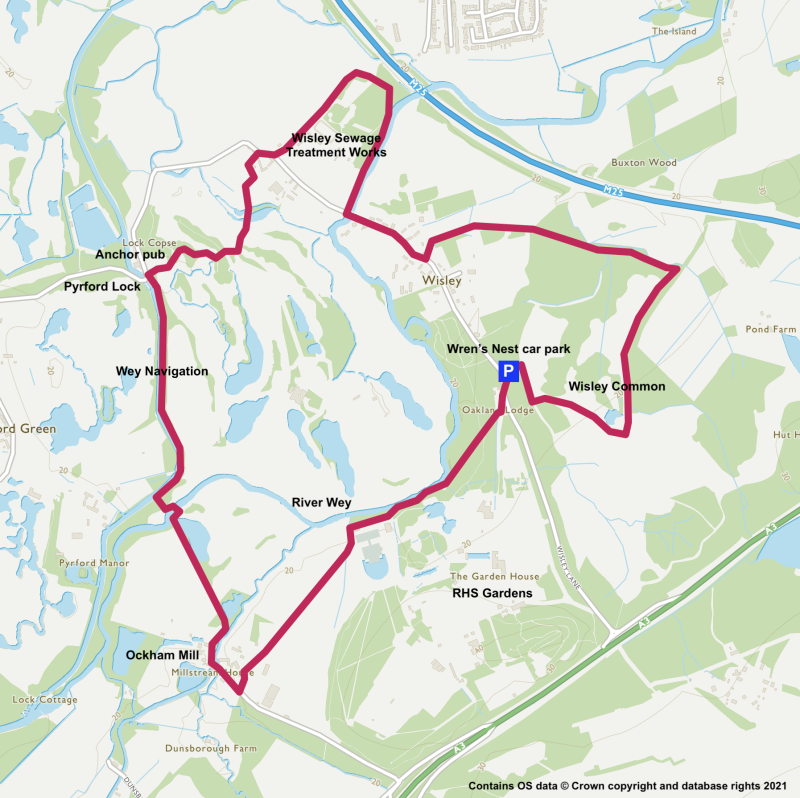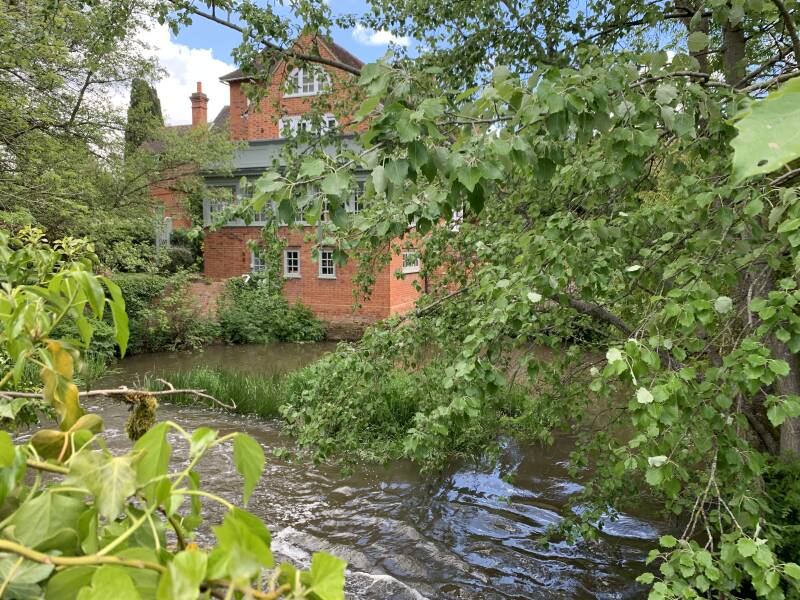Wisley Common and Wey Navigation
Some lovely heathland, a bird rich sewage farm and pretty riverside and canalside paths.
Start this walk at the Wren’s Nest car park on Wisley Lane on the opposite side to the RHS Gardens car parks. Nearest postcode GU23 6QD.
Exit the car park onto Wisley Common, home to Nightjars, Woodlark and Dartford Warblers. From the entrance gate follow the main path to the right with trees on your right. Soon you reach a circular clearing where trees have been removed. Turn left here on the grassy track and go through the trees onto the open heath beyond and follow the path across the heath in the same direction. Listen and watch for Dartford Warblers, Whitethroats, Chiffchaffs and watch for dragonflies and butterflies. There’s a good chance of finding the Common Heath Moth with its feathered antennae. Dartford Warblers are quite audible with their scolding calls but while they are nesting they can be more silent. Seeing them is difficult: they often sing from the top of heather, gorse, or from the lower branches of the small trees. A small bird, they may fly just a few inches above the heather on their territory. For Nightjars you will need to come here at dusk. Other heathland birds like Stonechats and Tree Pipits may be found and possibly some Willow Warblers, a few unmated males singing through the summer. Keep walking in the same direction and soon you will see a pond on your left and meet a T junction bridleway/path. Turn left. Stay on this path and it goes through some trees and then skirts the heath where I found many Linnets in May. On the right you will find is a parallel track that runs through the avenue of trees and gives views of the meadows on the right. In the trees will be all the tit family, nuthatches and if you’re very lucky a Treecreeper. Both paths will be enjoyable.
The paths reach a point at the end of the heath where you see a water trough for the cattle. Turn 45 degrees left on the widest path into the trees and follow this path left again where it meets another from the right, through the mixed woodland. Cross a small stream and sleeper footbridge and where the path splits take the right-hand option – this is signposted as a footpath – ignore the permissive bridleway. Great Spotted Woodpeckers should be found here. Keep going across two footpath crossroads until you reach some new gates at the end of the woodland and an archery field to the right. Go through the new gates and this takes you along a pleasant stretch of land with hedgerows and open areas for wild flowers like red campion, greater celandine, forget-me-nots and lots of cow parsley. At the time of writing after a cold wet spell, I have yet to find butterflies here but undoubtedly will when the sun shines! Over on the right, not on your path, at the end of the row of trees in front of you, is a superb old oak tree, probably about 500 years old! If you go to see it return to the same path you were on and follow it as it passes through the gap at the left end of the row of trees. The path narrows with a ditch on the left with lots of wild flowers in spring. You emerge onto a concrete track and turn left to the road. Cross to the footpath and turn right.
There’s still a nice little colony of house sparrows here. Goldfinches are around the houses and gardens. Beyond the hedgerow on the left are fields and a couple of stables. Anywhere with stables should be good for finding swallows. Continue along the roadside footpath, cross the bridge over the River Wey and turn right on the footpath for a real treat! This is Wisley Sewage Treatment Works!
In spring and summer (especially months May to August) the air is likely to be full of Swifts, Swallows and House Martins. The treatment beds will be attracting Pied Wagtails, Grey Wagtails, Jackdaws, Crows and Magpies. On your right if the River Wey and a likely spot for Kingfishers. On my visit I found Mandarin duck in the shadows and grey wagtails on overhanging branches. The path goes in a big loop around a fenced area, ignore the right turn at the back of the Works area which passes under the M25 just a few yards away. As the path turns back meadows open up on your right. The meadows held belted Galloway cattle on my visits, these are owned by Surrey Wildlife Trust who manage this and other local land for the owner who I had the pleasure to meet on my last visit. He told me about the Red Fox I saw in the field, apparently very tame but best not tested! He also saw a Little Egret there just a week before my visit.
On reaching the road turn right and cross carefully into the churchyard. Wild comfrey grows just outside the gate. Follow the path through the churchyard, keeping on the hard surface as it passes the church. This is 12thC and has traces of frescos inside and three of the original consecration crosses. It was locked! The path leaves the churchyard - follow the sign to the right and this path takes you to the golf course. Please take care – golf balls are hard and this path crosses a fairway. You appear between two ponds and cross carefully to the tarmac road and turn right. Apart from pied wagtails the most noticeable birds here may be noisy ring-necked parakeets or geese! Where the tarmac track splits take another right turn (there is a footpath sign with many options, you’ll see the arrow to the right). The tarmac track splits again soon and turn right once more (there is no footpath sign here). Once again it splits and take the left turn following it until your footpath leaves the tarmac and goes off to the right before the ‘Private’ sign in the hedge. You will end up at Pyrford Lock with The Anchor pub to your right. A beauty spot, well known by many.
After stopping or admiring, turn left along the canal towpath past the private car park and lock. You have a lovely hedgerow of mature trees on your left and on the other side of the canal more golf course beyond the trees and hedgerow. Keep watching the canal as Kingfishers and Moorhens may be seen. Continuing along the towpath as it bends to the right, pass a bridge and about one hundred metres after take a footpath signposted on your left into the hedgerow. There may be diversion signs across a bridge via the golf course and back to the official footpath. Stay on this path enjoying the hedgerows until you finally emerge onto a vehicle track at Ockham Mill. Look with envy at the homes here but also enjoy the Mill Tail (stream) as it passes under the bridge. Follow the lane away from the buildings and look for the footpath on the left directly opposite another footpath appearing from the right.
This now passes one or two houses, gardens and horse paddocks on the left and open fields on the right. After the horse paddocks on the left, when I walked this path in May a field was full of spring flowers and only the edges had been mown leaving a beautiful display. I was unable to get close enough for a really good photograph. This long straight path soon reaches a hedge, cross the lane and follow the footpath sign opposite into the hedgerow.
This path takes you past the RHS Gardens with occasional limited views. The River Wey will appear on your left giving some more nice views and you then briefly sneak through the RHS garden via a series of gates with warnings not to join the paying throng either side of the path. Very soon after this you reach Wisley Lane and turn left. A short way along you will see Wren’s nest car park where your car should be waiting.
Ockham Mill across the Mill Tail
A donation helps to keep this website growing.



